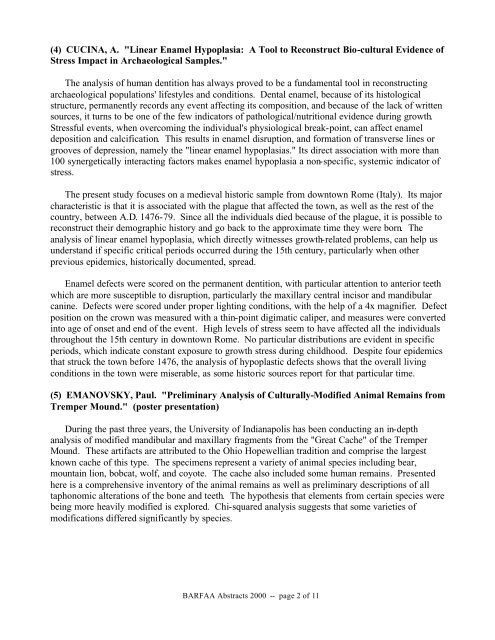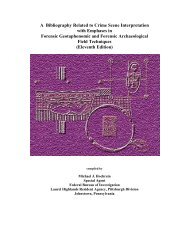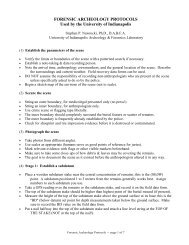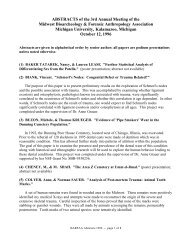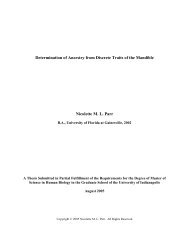Abstracts - University of Indianapolis Archeology & Forensics ...
Abstracts - University of Indianapolis Archeology & Forensics ...
Abstracts - University of Indianapolis Archeology & Forensics ...
Create successful ePaper yourself
Turn your PDF publications into a flip-book with our unique Google optimized e-Paper software.
(4) CUCINA, A. "Linear Enamel Hypoplasia: A Tool to Reconstruct Bio-cultural Evidence <strong>of</strong><br />
Stress Impact in Archaeological Samples."<br />
The analysis <strong>of</strong> human dentition has always proved to be a fundamental tool in reconstructing<br />
archaeological populations' lifestyles and conditions. Dental enamel, because <strong>of</strong> its histological<br />
structure, permanently records any event affecting its composition, and because <strong>of</strong> the lack <strong>of</strong> written<br />
sources, it turns to be one <strong>of</strong> the few indicators <strong>of</strong> pathological/nutritional evidence during growth.<br />
Stressful events, when overcoming the individual's physiological break-point, can affect enamel<br />
deposition and calcification. This results in enamel disruption, and formation <strong>of</strong> transverse lines or<br />
grooves <strong>of</strong> depression, namely the "linear enamel hypoplasias." Its direct association with more than<br />
100 synergetically interacting factors makes enamel hypoplasia a non-specific, systemic indicator <strong>of</strong><br />
stress.<br />
The present study focuses on a medieval historic sample from downtown Rome (Italy). Its major<br />
characteristic is that it is associated with the plague that affected the town, as well as the rest <strong>of</strong> the<br />
country, between A.D. 1476-79. Since all the individuals died because <strong>of</strong> the plague, it is possible to<br />
reconstruct their demographic history and go back to the approximate time they were born. The<br />
analysis <strong>of</strong> linear enamel hypoplasia, which directly witnesses growth-related problems, can help us<br />
understand if specific critical periods occurred during the 15th century, particularly when other<br />
previous epidemics, historically documented, spread.<br />
Enamel defects were scored on the permanent dentition, with particular attention to anterior teeth<br />
which are more susceptible to disruption, particularly the maxillary central incisor and mandibular<br />
canine. Defects were scored under proper lighting conditions, with the help <strong>of</strong> a 4x magnifier. Defect<br />
position on the crown was measured with a thin-point digimatic caliper, and measures were converted<br />
into age <strong>of</strong> onset and end <strong>of</strong> the event. High levels <strong>of</strong> stress seem to have affected all the individuals<br />
throughout the 15th century in downtown Rome. No particular distributions are evident in specific<br />
periods, which indicate constant exposure to growth stress during childhood. Despite four epidemics<br />
that struck the town before 1476, the analysis <strong>of</strong> hypoplastic defects shows that the overall living<br />
conditions in the town were miserable, as some historic sources report for that particular time.<br />
(5) EMANOVSKY, Paul. "Preliminary Analysis <strong>of</strong> Culturally-Modified Animal Remains from<br />
Tremper Mound." (poster presentation)<br />
During the past three years, the <strong>University</strong> <strong>of</strong> <strong>Indianapolis</strong> has been conducting an in-depth<br />
analysis <strong>of</strong> modified mandibular and maxillary fragments from the "Great Cache" <strong>of</strong> the Tremper<br />
Mound. These artifacts are attributed to the Ohio Hopewellian tradition and comprise the largest<br />
known cache <strong>of</strong> this type. The specimens represent a variety <strong>of</strong> animal species including bear,<br />
mountain lion, bobcat, wolf, and coyote. The cache also included some human remains. Presented<br />
here is a comprehensive inventory <strong>of</strong> the animal remains as well as preliminary descriptions <strong>of</strong> all<br />
taphonomic alterations <strong>of</strong> the bone and teeth. The hypothesis that elements from certain species were<br />
being more heavily modified is explored. Chi-squared analysis suggests that some varieties <strong>of</strong><br />
modifications differed significantly by species.<br />
BARFAA <strong>Abstracts</strong> 2000 -- page 2 <strong>of</strong> 11


